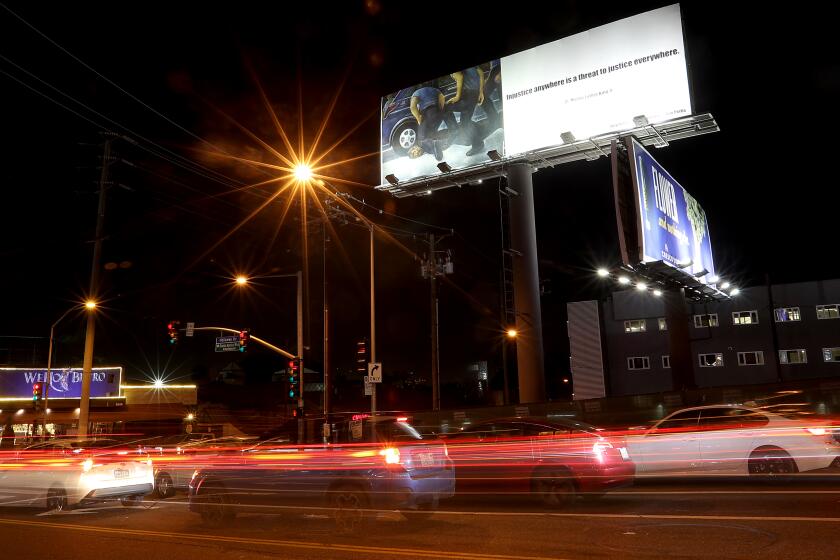How do you move a $50 million Diego Rivera mural? An S.F. school hopes not to find out
- Share via
A Diego Rivera mural estimated to be worth $50 million has sparked outcry from artist Catherine Opie and others who worry that its owner, the financially troubled San Francisco Art Institute, might sell the work to keep its doors open.
The school grounds and buildings — but not the 1931 mural — are owned by the University of California, which paid off the art institute’s $19.7 million bank debt last fall in order to save the 150-year-old school from losing its Chestnut Street campus in a foreclosure sale.
The art institute has up to six years to pay off this debt, plus interest and minus its lease payments, if it wants to reclaim ownership of the property, spokeswoman Sara Fitzmaurice said. If it cannot pay off or refinance that amount by 2026, UC will take possession and the art institute will vacate.
The school acknowledged that if it does have to vacate, it might need to move the Rivera mural, titled “The Making of a Fresco Showing the Building of a City,” Fitzmaurice said. The board has begun “a feasibility study on if and how the mural could potentially be moved,” she added.
Filmmaker George Lucas is reportedly interested in buying the mural for the in-the-works Lucas Museum of Narrative Art in L.A. The San Francisco Museum of Modern Art also has been mentioned as a party that could take ownership but leave the mural in place on campus as part of an annex.
The Lucas Museum declined to comment. Pam Rorke Levy, chair of the art institute’s board of trustees, would say only that “a number of conversations have been taking place with several institutions about the possibility to endow or acquire the mural to ensure the future of the school and uphold our mission.”
In the meantime, the possible sale has prompted many to speak out, including prominent alumni such as Opie, who received her bachelor’s degree from San Francisco Art Institute in 1985. In an open letter, Opie wrote that selling the mural would be an “incredibly unconscionable decision,” and that as a result she will be pulling a piece of her work from an upcoming auction for alumni works.
“Solely the fact that the Diego Rivera mural has become a monetary asset in the minds of the trustees; an asset thought to help the institution survive,” Opie wrote. “Of course, I want SFAI to survive, but not by gutting one of the most important artworks in the history of the institution. The Diego Rivera mural has lived and inspired many generations of artists at 800 Chestnut.”
Whether the school sells the artwork to remain on Chestnut Street or brings the Rivera with it to a new home, the question remains: How, exactly, does one move a $50 million piece of monumental art without wrecking it?
Curator and art conservator Rosa Lowinger has successfully moved large-scale architectural artworks including an exterior mosaic by Bruce Hayes at Houston Methodist Hospital and a Millard Sheets glass mosaic designed for a savings and loan building in Santa Monica. She said moving the Rivera wouldn’t be easy but could be done.
Lowinger said a project of that scale could take up to two years and could cost between $1.5 million and $2 million, excluding whatever repairs might be needed in the building from which the mural was removed.
From a conservator’s point of view, the priority is the health of the artwork. A great deal of attention must be devoted to an initial exploratory phase, examining the structure and material of the wall housing the mural as well as the medium and substrate of the art itself. Is the mural a true fresco, a painting on panels, a fresco on panel or something else?
The art institute was told during its feasibility study that the mural is not painted directly on the wall. If this is the case, Lowinger said, a conservator would need to know how it is affixed to the wall.
“Presumably there is information on how Rivera typically did this, since he did it more than once before. But even if there is not, there are probes that can be done to ascertain the manner of attachment and how it comes apart, if it does,” Lowinger said. If the mural was brought in on panels, knowing how they were installed would be crucial.
Another question: Can the mural be laid on a flatbed truck for transportation?
“These are vertical works of art, and in order to lay them down horizontally there is a lot of reinforcement that needs to be done,” Lowinger said. “You don’t want to create any buckling or stresses.”
The paint on the mural would have to be protected in some way, likely with a layer of Japanese tissue and an adhesive that would not cause damage upon removal.
Lowinger generally works with a team that would include an engineer, a contractor and a qualified art-handling team.
In a statement to The Times, Levy said that the board’s first choice would not be to sell the Rivera mural but to endow it in place, “attracting patrons or a partner organization who would create a substantial fund that would enable us to preserve, protect and present the mural to the public, as well as helping the board fulfill its fiduciary role to protect the school as an educational institution and ensure its future survival.”
The art, rejected by two major billboard companies, is the George Floyd Justice Billboard Committee’s effort to keep a brutal death front and center.
More to Read
The biggest entertainment stories
Get our big stories about Hollywood, film, television, music, arts, culture and more right in your inbox as soon as they publish.
You may occasionally receive promotional content from the Los Angeles Times.












